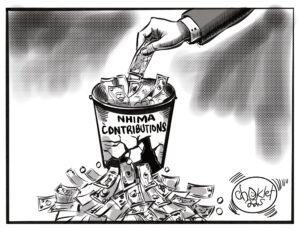INDUSTRIAL Development Corporation (IDC) Chief Investments Officer Muchindu Kasongola says the purchase of 49 per cent shares in Chinese owned manufacturing Company Marcopolo was arrived at following a thorough evaluation process which revealed that the company was profitable from the onset.
And Kasongola says the amount of time Marcopolo had been in operation was not a huge benchmark in deciding whether to invest as the company had completed four profitable financial years prior.
Meanwhile, Kasongola says it was unnecessary for IDC to employ a licenced broker to manage the transaction.
Last week, a News Diggers investigation revealed that IDC, National Pensions Scheme (NAPSA) and The Workers Compensation Fund Control Board paid two Chinese investors Zhang Lingling and Huang Yaochi $48.8 million as a consideration for the purchase of a minority stake in Marcopolo.
But several stakeholders have challenged IDC to avail the valuation report that will inform the public why Marcopolo Tiles was valued at $2,000 per share.
Explaining the investment decision on Hot FM, Wednesday, Kasongola said Marcopolo was a very profitable company which would boost import substitution.
“…entities such as Marcopolo can support the country’s ability to add to foreign exchange. As you are aware, Marcopolo products are not only consumed locally but the target markets include regional markets including the DRC, Tanzania, Malawi, Zimbabwe and now we are making entry into the Great Lakes’ Region Rwanda; Kenya and Burundi. So, the motivation around import substitution, around investing in entities where we create an import substitution effect, that we are able to produce products that otherwise we would have to import and that way we decrease the pressure for demand for foreign exchange and we begin to support our local currency and I think we are all alive to the impact of a stronger currency or around things like inflation and purchasing power of local households. So those are some of the things that motivated our investment in Marcopolo,” Kasongola said.
And Kasongola said it did not matter that Marcopolo was a fairly new company because their projections were impressive.
“First of all, I would like to just state that at the time we began to engage Marcopolo investment, the entity had already completed three, four financial years. So, we started looking at Marcopolo investments in early 2020. So, we did have the benefit of looking at the prior history of financial performance and this basically formed our assessment around investment decisions and things around evaluation. One of the unique features of Marcopolo is that it procures 90 percent of the raw materials that are required in its production process locally. And these are essentially raw materials that you would have otherwise been paying a huge cost for, but because of the way the value chain of Marcopolo is organised, this helps to reduce the cost of production instantly,” Kasongola said.
“You did speak to amounts of investments and essentially the valuation or any consideration that goes with the acquisition of any entities that we have invested in are basically formed by valuation that are governed by conversion of best practices. And key to this would be benchmarks around where the net assets is sitting and this is usually the starting point. We also look at among other things revenue generating capacity of the entity, its profitability, what the growth focus looks like, what the cost of capital is and what our payback will be as well. So, these are some of the benchmarks that drive the decisions. I think it’s not necessarily the amount of time that the company has been running for but rather what are the earnings that are actually attributed to that particular investment.”
He said the acquisition of shares was arrived at through a convention of best practice evaluation methodologies which can be verified with independent experts.
“And therefore, you are able then to deliver products which are tiles at a price that is lower than the price of products that are imported but also at profit margins that enable you to be able to be profitable almost on the onset. So, I was basically trying to explain the cost structure of Marcopolo and why the company was profitable right from the first operation which was 2017. And I did speak to the cost structure which essentially constituted materials that allow that company to be able to make reasonable margins. In addition, I did speak to the fact that 90 percent of these materials are basically sourced locally. So, the motivation was that essentially, this is an opportunity sitting right at the heart of a sector where we have deliberately driven to increase our exposure. So, this opportunity basically speaks a lot to what we are trying to achieve locally. Also, we were directly attracted by the fact that it was sitting in a sector that allows us to create jobs, achieve import substitution and all those factors speak to what the IDC is all about,” he said.
“To answer your question of the amount of money that has been made over the last three years, Marcopolo has been able to consistently generate revenue around $20 million. In the year 2020, Marcopolo generated close to $25 million in revenues. On average, the net income which is basically a profit has been averaging anywhere between $11.5 million to $12 million. This is expected to increase to $15 million with the inclusion of sanitary wear products. Now, on average when you look at evaluation conversion, valuation of the going concern, a going concern which is a company that will be able to continue operations in the foreseeable future, will be sitting in the range of anywhere between seven to 10 times of the average annual net earnings. And if you take the net earnings of say about $12 million per annum, on average, this will be $120 million. And as you may be aware, the Marcopolo acquisition will be concluded at the evaluation of $91.5 million and how the 49 per cent stake that was acquired by IDC, NAPSA and Workers and Compensation and Control Board was valued at $48.4 million that you alluded to. So, in short, the valuation that went with Marcopolo investment is one that was done under the convention of best practice evaluation methodologies and this can be confirmed with independent experts as it speaks to the initial asset value which was sitting at over $200 million.”
He insisted that it was not exorbitant to acquire Marcopolo shares for $48.8 million.
“And there is an additional component which formed part of our due diligence which was around are you are able to secure sufficient raw materials to ensure that Marcopolo can continue to operate for the next 10 to 20 years. And so, the mining rights that are associated with the raw materials that go to the tile manufacturing process also constituted the key part of our valuation and this is what enhanced the net asset value. However, the net asset value was not the basis on which we concluded the acquisition, we concluded the acquisition based on the kind of profit we expect to benefit from as a result of the company and then net earning which are in the multiples of 10 which essentially is governed by best practice conversion. And that means the $91 million that was ascribed to the Marcopolo acquisition is not exorbitant from a relative perspective,” Kasongola said.
“What is important to note is that the valuation of the entity is driven by revenues and what kind of profits the company is able to generate. We can base the valuation on costs but when we looked at valuation based on assets, it was returning values that were worth excess of the value at which we were able to conclude the transaction. So, I’m not sure, I’m not in a position to comment on the investment you alluded to which is the $35 million but the valuations were based on the variables I alluded to. Based on the numbers from the audited accounts that we reviewed and these are examined accounts, as of 2019, assets valuation which basically the total assets without all the liabilities attributed to the company, plus the additional assets associated with the raw materials that go into the production process, was turning to $200 million, that’s our assessment. The valuation was in excess of $200 million.”
Meanwhile, Kasongola says IDC did not employ a licenced broker to manage the transaction.
“I must again correct the misrepresentation on the independent broker. This was an acquisition of a company which was listed on the stock exchange, so there is no specific requirement to have a licenced broker to basically manage the transaction. So, this transaction was handled by IDC experts and NAPSA and Workers Compensation and Control Board. In terms of the process, there was a prospectus which was essentially the document that invites investors to look at the opportunity. And this prospectus was specifically sent for the consideration of the IDC, ZCCM-IH, NAPSA and Workers Compensation and Control Board. In terms of the prospectus, this was prepared by Marcopolo tiles with the independent experts and they had ascribed the value to Marcopolo in the prospectus of the $27.5 million. And again, this is the evaluation which is much higher than the valuation that was ultimately concluded as the acquisition price,” said Kasongolo.
“Yes [Marcopolo] is profitable now and I must mention that in 2020 we were just given the final figures, Marcopolo turned a revenue of about $25 million. You are aware that the sanitary wear products are now being commissioned and this is expected to add an additional $10 to $15 million to the revenues. And this again should increase the net profit to about $50 million per annum. So, the prospects are very good. The payback period is expected to be somewhere between five to six years. A five to six years return on investment basically speaks to a very attractive return.”

























One Response
A lot of words going round and round but meaning nothing. In just one year we will see if there is any substance in this. If the money paid is followed it may turn out that some of it ended in the pockets of those who paid on our behalf.